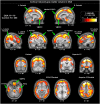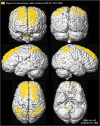Reduced Regional Grey Matter Volumes in Pediatric Obstructive Sleep Apnea
- PMID: 28303917
- PMCID: PMC5355989
- DOI: 10.1038/srep44566
Reduced Regional Grey Matter Volumes in Pediatric Obstructive Sleep Apnea
Abstract
Pediatric OSA is associated with cognitive risk. Since adult OSA manifests MRI evidence of brain injury, and animal models lead to regional neuronal losses, pediatric OSA patients may also be affected. We assessed the presence of neuronal injury, measured as regional grey matter volume, in 16 OSA children (8 male, 8.1 ± 2.2 years, AHI:11.1 ± 5.9 events/hr), and 200 control subjects (84 male, 8.2 ± 2.0 years), 191 of whom were from the NIH-Pediatric MRI database. High resolution T1-weighted whole-brain images were assessed between groups with voxel-based morphometry, using ANCOVA (covariates, age and gender; family-wise error correction, P < 0.01). Significant grey matter volume reductions appeared in OSA throughout areas of the superior frontal and prefrontal, and superior and lateral parietal cortices. Other affected sites included the brainstem, ventral medial prefrontal cortex, and superior temporal lobe, mostly on the left side. Thus, pediatric OSA subjects show extensive regionally-demarcated grey matter volume reductions in areas that control cognition and mood functions, even if such losses are apparently independent of cognitive deficits. Since OSA disease duration in our subjects is unknown, these findings may result from either delayed neuronal development, neuronal damaging processes, or a combination thereof, and could either reflect neuronal atrophy or reductions in cellular volume (neurons and glia).
Conflict of interest statement
The authors declare no competing financial interests.
Figures



Similar articles
-
Regional brain tissue integrity in pediatric obstructive sleep apnea.Neurosci Lett. 2018 Aug 24;682:118-123. doi: 10.1016/j.neulet.2018.06.002. Epub 2018 Jun 5. Neurosci Lett. 2018. PMID: 29883682 Free PMC article.
-
Volumetric brain magnetic resonance imaging analysis in children with obstructive sleep apnea.Int J Pediatr Otorhinolaryngol. 2020 Nov;138:110369. doi: 10.1016/j.ijporl.2020.110369. Epub 2020 Sep 7. Int J Pediatr Otorhinolaryngol. 2020. PMID: 32927352
-
Neurocognitive dysfunction and grey matter density deficit in children with obstructive sleep apnoea.Sleep Med. 2014 Sep;15(9):1055-61. doi: 10.1016/j.sleep.2014.04.011. Epub 2014 Jun 6. Sleep Med. 2014. PMID: 25023925
-
Cortical and Subcortical Gray Matter Volume in Youths With Conduct Problems: A Meta-analysis.JAMA Psychiatry. 2016 Jan;73(1):64-72. doi: 10.1001/jamapsychiatry.2015.2423. JAMA Psychiatry. 2016. PMID: 26650724 Review.
-
What does the grey matter decrease in the medial prefrontal cortex reflect in people with chronic pain?Eur J Pain. 2019 Feb;23(2):203-219. doi: 10.1002/ejp.1304. Epub 2018 Sep 4. Eur J Pain. 2019. PMID: 30101509 Review.
Cited by
-
Neurobehavioral morbidity of pediatric mild sleep-disordered breathing and obstructive sleep apnea.Sleep. 2022 May 12;45(5):zsac035. doi: 10.1093/sleep/zsac035. Epub 2022 Feb 12. Sleep. 2022. PMID: 35554583 Free PMC article.
-
Associations between body mass index, sleep-disordered breathing, brain structure, and behavior in healthy children.Cereb Cortex. 2023 Sep 9;33(18):10087-10097. doi: 10.1093/cercor/bhad267. Cereb Cortex. 2023. PMID: 37522299 Free PMC article.
-
Regional brain tissue integrity in pediatric obstructive sleep apnea.Neurosci Lett. 2018 Aug 24;682:118-123. doi: 10.1016/j.neulet.2018.06.002. Epub 2018 Jun 5. Neurosci Lett. 2018. PMID: 29883682 Free PMC article.
-
Alterations in Amygdala/Hippocampal Volume Ratios in Children with Obstructive Sleep Apnea Syndrome Caused by Adenotonsillar Hypertrophy.Med Sci Monit. 2023 Mar 15;29:e937420. doi: 10.12659/MSM.937420. Med Sci Monit. 2023. PMID: 36918755 Free PMC article.
-
Prevalence of high-risk for obstructive sleep apnea in attention deficit hyperactivity disorder children referred to psychiatry clinic and impact on quality of life.Front Psychiatry. 2022 Jul 22;13:926153. doi: 10.3389/fpsyt.2022.926153. eCollection 2022. Front Psychiatry. 2022. PMID: 35935414 Free PMC article.
References
-
- Kheirandish-Gozal L. & Gozal D. Sleep disordered breathing in children: a comprehensive clinical guide to evaluation and treatment. New York: Humana Press; (2012).
-
- Galland B., Spruyt K., Dawes P., McDowall P. S., Elder D. et al.. Sleep disordered breathing and academic performance: A meta-analysis. Pediatrics 136, e934–946 (2015). - PubMed
-
- O’Brien L. M. et al.. Neurobehavioral correlates of sleep-disordered breathing in children. Journal of sleep research 13, 165–172 (2004). - PubMed
Publication types
MeSH terms
LinkOut - more resources
Full Text Sources
Other Literature Sources
Medical

